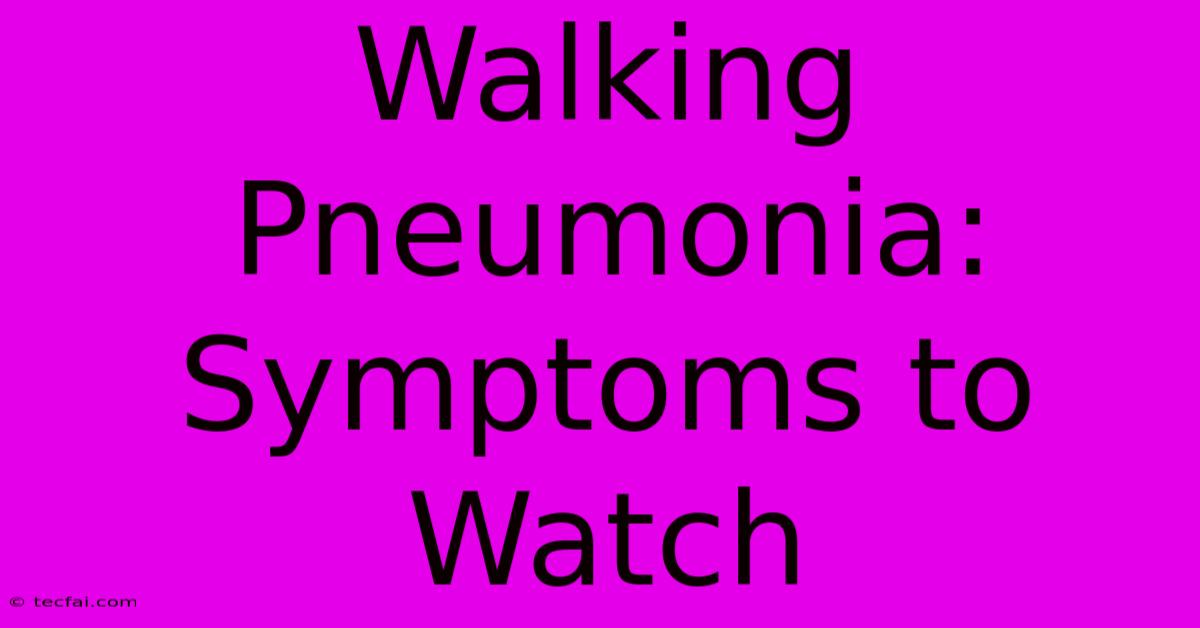Walking Pneumonia: Symptoms To Watch

Discover more detailed and exciting information on our website. Click the link below to start your adventure: Visit Best Website tecfai.com. Don't miss out!
Table of Contents
Walking Pneumonia: Symptoms to Watch
Walking pneumonia, also known as atypical pneumonia, is a form of lung infection. Unlike typical pneumonia, it's often milder and doesn't always require bed rest, hence the name "walking." However, this doesn't mean it's something to ignore. Understanding the symptoms of walking pneumonia is crucial for seeking timely treatment and preventing complications.
Understanding Walking Pneumonia
Walking pneumonia is primarily caused by Mycoplasma pneumoniae, a type of bacteria different from those causing typical pneumonia. This difference contributes to the less severe, but still potentially problematic, symptoms. It spreads through respiratory droplets produced when an infected person coughs or sneezes. While often less severe than bacterial pneumonia, it can still lead to serious complications if left untreated, particularly in young children, older adults, and individuals with weakened immune systems.
Key Differences from Typical Pneumonia
It's important to differentiate walking pneumonia from typical pneumonia caused by bacteria like Streptococcus pneumoniae or Haemophilus influenzae. Typical pneumonia often presents with more severe symptoms, including high fever, chills, and significant coughing fits. Walking pneumonia, while still an infection, tends to present with a milder set of symptoms, making it easy to initially overlook or misdiagnose as a common cold.
Recognizing the Symptoms of Walking Pneumonia
While the symptoms can vary from person to person, here are some key indicators to watch out for:
Common Symptoms:
- Persistent Cough: This is often one of the first and most prominent symptoms. It might be dry at first, gradually becoming productive (producing mucus).
- Fatigue: Feeling unusually tired and weak is a common complaint.
- Mild Fever: While a high fever is less characteristic of walking pneumonia, a low-grade fever (under 102°F) might be present.
- Headache: A persistent headache can accompany the infection.
- Body Aches: Muscle and joint pain can be experienced.
- Sore Throat: Similar to a common cold, a sore throat might also occur.
- Shortness of Breath: This is a more serious symptom and warrants immediate medical attention.
Less Common but Important Symptoms:
- Skin Rash: Some individuals might develop a characteristic skin rash.
- Earache: Inflammation of the middle ear can occur as a complication.
- Nausea and Vomiting: Though less frequent, digestive issues can accompany walking pneumonia.
When to Seek Medical Attention
While some symptoms might be mild and manageable at home, it's crucial to consult a doctor if you experience:
- Worsening symptoms: Any significant increase in severity or the development of new symptoms requires medical evaluation.
- Shortness of breath: This indicates a potentially serious complication and needs immediate attention.
- High fever: A high fever (above 102°F) suggests a more severe infection.
- Persistent cough lasting more than two weeks: A prolonged cough warrants medical attention to rule out any underlying issues.
- Weakened immune system: Individuals with compromised immune systems should seek medical advice at the first sign of any respiratory symptoms.
Diagnosis and Treatment
Diagnosis of walking pneumonia typically involves a physical examination, reviewing your medical history, and sometimes chest X-rays to rule out other conditions. A blood test can also detect antibodies to Mycoplasma pneumoniae. Treatment usually involves antibiotics, though the choice of antibiotic depends on the severity of the infection and the individual's health status.
Disclaimer: This article is intended for informational purposes only and does not constitute medical advice. Always consult a healthcare professional for any health concerns or before making any decisions related to your health or treatment. Self-treating can be dangerous, and a proper diagnosis is essential for effective treatment and preventing complications.

Thank you for visiting our website wich cover about Walking Pneumonia: Symptoms To Watch. We hope the information provided has been useful to you. Feel free to contact us if you have any questions or need further assistance. See you next time and dont miss to bookmark.
Featured Posts
-
Panalo Ng Nets Laban Sa Kings
Nov 26, 2024
-
Lotto Resulta Swertres 9 Pm Nobyembre 25
Nov 26, 2024
-
Msms Wishes Happy Thanksgiving
Nov 26, 2024
-
Jon Benets Father New Optimism
Nov 26, 2024
-
Panalo Sino Mavericks Vs Heat Nov 24 2024
Nov 26, 2024
